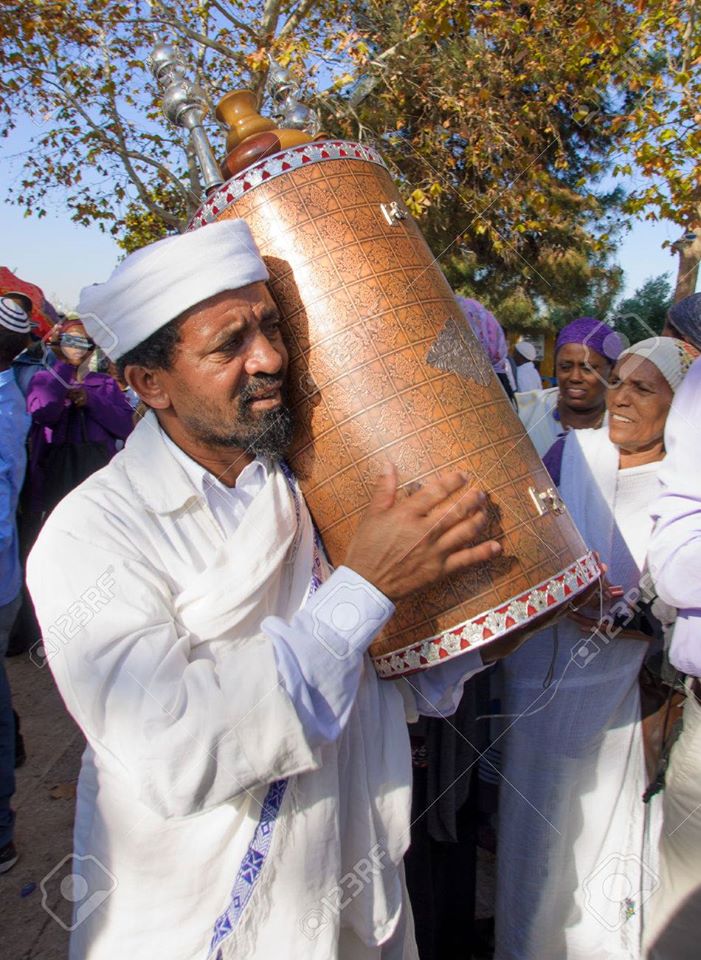JAÑ AMHARA: ORIGINE DU PATRONYME YANDA OU DANG.
JAÑ AMHARA: ORIGINE DU PATRONYME YANDA OU DANG.
Introduction: Belle image du Kä-Seth à Jérusalem par des leaders Yehuude Ye-Ityoyôppya (francisé Juifs éthiopiens par les peuples des nations de l'ancien grand royaume du Beta Ye-Iza'Yele Tsimi du Ye-Ityoyôppya métropolitain (francisé Beta Israël Semiens kingdom).
Sur cette image nous voyons des leaders Beta Ye-Iza'Él Tsimi de l'Israël de l'État du Ye-Iza'Yele (francisé Israël) des temps modernes portant la Sainte Otông'Arâm ou Otôngô-Amhara ou Tông-Ùki (francisé Torah) à la fin d'une possession annuelle de la fête de l'Ésiiki >> à Jérusalem.
Nous avons choisi cette image parce que nous parlons ici de la suite de notre exemen sur les origines patriarcales Dijamaack Mintsa-Menye-M'Éfaa Kresto (anglicisé respectivement Mitsa-Menya-Afa et Itsa-Manyi-Afa) de la grande dynastie royale Ngè'Owôn (anglicisé Gedewon et Gedeon) de l'ancien grand royaume métropolitain du Beta Ye-Iza'Yele Tsimi de l'empire du Ye-Ityoyôppya.
ORIGINE DU PATRONYME ET TOPONYME " YANDA ":
D'après la grande encyclopédie " Solomonic-Royal Ark ", Ethiopia Volume VI et VII, des archives du grand musée impérial du Ye-Itiyôppya à Addis-Abäba nous lisons :
<< According to the Beta Israel tradition, during its time the kingdom was called the "Kingdom of the Gideons", after the name of the Jewish kings dynasty that ruled it. A document from the 10th century by an Arab historian states that the name of the kingdom which took over the empire of Aksum after the revolt of Queen Judith is "ha-Dani". This document validates the documents of Eldad ha-Dani, who mentioned that the Tribe of Dan exiled voluntarily and established an independent kingdom. Between the 15th century and the early 17th century the Ethiopian Empire referred to the kingdom as "Falasha". This name was later on popularized and also appears in Jewish writings from that period. The 16th century geographer Livio Sanuto referred to the kingdom as "Land of the Jews" ("Judaeorum Terra") in his "Tabula X" map published in 1588. Leo Africanus also referred to the kingdom of Beta Israel as "Land of the Jews" ("terra de' Giudei") >>.
D'après ce que nous venons de lire dans la grande encyclopédie " Solomonic-Royal Ark " Éthiopia, nous donnons les origines du patronyme Yanda qui vient du nom " Adan " ou " Ha-Dan " ou encore " Anda " et qui dans le contexte d'une nation ou d'une dynastie ou d'un lignage prend le suffixe " Ye " ou " Ya " des langues Ùri (francisé Araméen) comme le " Ngiisi " (francisé Guèze) devient " Ye-Anda ou Ye-Adan ou Ha-Anda (germanisé Yanda et Dang au Cameroun).
La grande dynastie royale Ngé'Owôn ou Ngè-Owôn (anglicisé respectivement Gedewon et Gedeon parfois même gidewon) de l'ancien royaume métropolitain du Beta Israël Tsimi est une dynastie de la nation du Yanda (francisé tribu de Dan ou royaume de Dan ou encore Danite), de l'ancien royaume métropolitain du Ye-Iza'Yele Agëw (francisé respectivement royaume d'Israël des dix tribus ou Israël du Nord ou Samarie).
Ce royaume était aussi connu sous le nom du Kâ'Naan Agëw.
Le terme " Agëw " ou " Akëw " dans les langues Ùri (Araméen ou Amharinya et Tigäranya) de l'Éthiopie métropolitaine désigne de l'amont d'un cours d'eau comme l'abbè'è ou Abiae (francisé Nil Bleu), et désigne par extension le nord
Alors si nous ramenons ce terme " agëw" dans les sous dialecte Atiisi dit " Zämaan " du Cameroun et de l'ensemble de sa sous-région " agëw " nous donnes ceci: Akoé, Akwè, Akui, Okwè, etc. alors nous pouvons dire Kâ'Naan-Akwè ou Ékang-Nna ya Okui et ainsi de suite.
La famille paternelle du prince (abbèè-ntôl) Mintsa-Menye-Éfaa Kresto alias " Mfaan Ndéna " était de la grande dynastie royale Ngè'Owôn et qui est elle-même une dynastie de la nation du Yanda, comme nous venons de le voir, une des dix nations qui composent les peuples du grand royaume Beta Ye-Iza'Yele Tsimi de l'empire du Ye-Ityoyôppya l'ancien empire d'Asüm.
ORIGINE MATRIARCALE DU DIJAMAACK MINTSA-MENYE-M'ÉFAA ALIAS " MFAAN NDÉNA " FONDATEUR DES YANDA DES TEMPS MODERNES.
À suivre.
Autres sources et références:
1- livre " Peoples of the Horn of Africa ( Somali, Afar, and Saho) : North Eastern of Africa, par 1, I. M. Lewis,
2- Mordechai Abir, The era of the princes: the challenge of Islam and the re-
unification of the Christian empire, 1769-1855 (London: Longmans, 1968).
3- Richard Pankhurst, The Ethiopian Borderlands (Lawrenceville: Red Sea Press, 1997), p. 60.
4- J. Spencer Trimingham, Islam in Ethiopia (Oxford: Geoffrey Cumberlege for the University Press, 1952).
NB: Fait à Düm-Ésamendjang Bouandjo, Campo Cameroun, par l'économiste et chercheur anthropologue Motto Carl Robert alias " Tata Motto'a Motto " avëb " 10 talaa'sas 2012 " de notre calendrier traditionnel et officiel du Ye-Ityoyôppya (ce qui correspond au mercredi 20 décembre 2019 du calendrier Ye-Romaani).
Photo: Sigd 2014
JERUSALEM - NOV 20th, 2014: A Kes, religious leader of the Ethiopian Jews, carrying the holy torah book, at the end of the annual Sigd holiday prays, in Jerusalem, Israel.
Inscrivez-vous au blog
Soyez prévenu par email des prochaines mises à jour
Rejoignez les 27 autres membres
